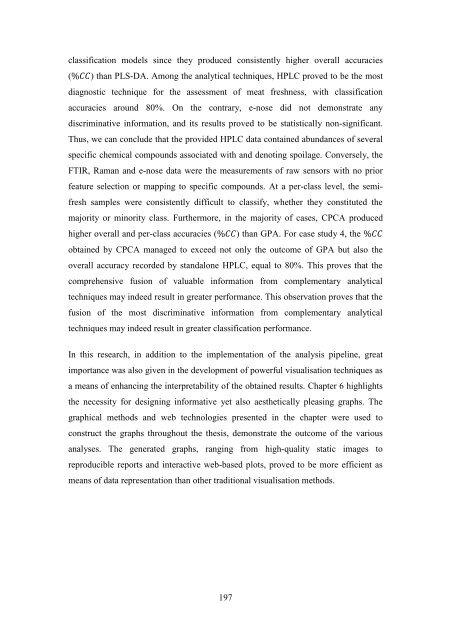CRANFIELD UNIVERSITY Eleni Anthippi Chatzimichali ...
CRANFIELD UNIVERSITY Eleni Anthippi Chatzimichali ...
CRANFIELD UNIVERSITY Eleni Anthippi Chatzimichali ...
You also want an ePaper? Increase the reach of your titles
YUMPU automatically turns print PDFs into web optimized ePapers that Google loves.
classification models since they produced consistently higher overall accuracies<br />
( ) than PLS-DA. Among the analytical techniques, HPLC proved to be the most<br />
diagnostic technique for the assessment of meat freshness, with classification<br />
accuracies around 80%. On the contrary, e-nose did not demonstrate any<br />
discriminative information, and its results proved to be statistically non-significant.<br />
Thus, we can conclude that the provided HPLC data contained abundances of several<br />
specific chemical compounds associated with and denoting spoilage. Conversely, the<br />
FTIR, Raman and e-nose data were the measurements of raw sensors with no prior<br />
feature selection or mapping to specific compounds. At a per-class level, the semifresh<br />
samples were consistently difficult to classify, whether they constituted the<br />
majority or minority class. Furthermore, in the majority of cases, CPCA produced<br />
higher overall and per-class accuracies ( ) than GPA. For case study 4, the<br />
obtained by CPCA managed to exceed not only the outcome of GPA but also the<br />
overall accuracy recorded by standalone HPLC, equal to 80%. This proves that the<br />
comprehensive fusion of valuable information from complementary analytical<br />
techniques may indeed result in greater performance. This observation proves that the<br />
fusion of the most discriminative information from complementary analytical<br />
techniques may indeed result in greater classification performance.<br />
In this research, in addition to the implementation of the analysis pipeline, great<br />
importance was also given in the development of powerful visualisation techniques as<br />
a means of enhancing the interpretability of the obtained results. Chapter 6 highlights<br />
the necessity for designing informative yet also aesthetically pleasing graphs. The<br />
graphical methods and web technologies presented in the chapter were used to<br />
construct the graphs throughout the thesis, demonstrate the outcome of the various<br />
analyses. The generated graphs, ranging from high-quality static images to<br />
reproducible reports and interactive web-based plots, proved to be more efficient as<br />
means of data representation than other traditional visualisation methods.<br />
197
















